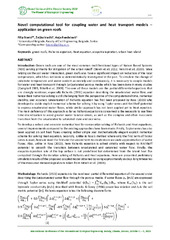Приказ основних података о документу
Novel computational tool for coupling water and heat transport models – application on green roofs
| dc.creator | Stanić, Filip | |
| dc.creator | Vasilić, Željko | |
| dc.creator | Ranđelović, Anja | |
| dc.date.accessioned | 2024-04-05T09:15:27Z | |
| dc.date.available | 2024-04-05T09:15:27Z | |
| dc.date.issued | 2023 | |
| dc.identifier.uri | https://www.iees.tuc.gr/ | |
| dc.identifier.uri | https://grafar.grf.bg.ac.rs/handle/123456789/3494 | |
| dc.description.abstract | Introduction: Green roofs are one of the most common multifunctional types of Nature Based Systems (NBS) serving primarily for mitigation of the urban runoff (Stovin et al. 2012, Versini et al. 2020). Since relying on the soil water interaction, green roofs also have a significant impact on reduction of the local temperature, which has not been so deterministically investigated in the past. To simulate the change of substrate temperature and water content accurately and continuously, it is necessary to couple models for water and heat transport through (un)saturated porous media which has been done in many studies (Campbell 1985, Bittelli et al. 2008). The core of these models are the partial differential equations that are strongly nonlinear, especially Richards (1931) equation describing the unsaturated water flow, and hence their numerical solving is still challenging from the perspective of the computational time, numerical stability, and accuracy. Linearization of Richards equation has first been proposed by Ross (2003) who developed a stable explicit numerical scheme for solving it by using Taylor series and Kirchhoff potential to express unsaturated water fluxes, while similar approach has not been applied yet to Heat equation. The main deficiency of this approach as far as Richards equation is concerned is the necessity to use finer time discretization to avoid greater water balance errors, as well as the complex and often inaccurate transition from the unsaturated to saturated state and vice versa. To develop a robust and accurate numerical tool for consecutive solving of Richards and Heat equations, several improvements compared to the existing approaches have been made. Firstly, Taylor series has also been applied on soil heat fluxes creating rather simple and mathematically elegant explicit numerical scheme for solving Heat equation. Secondly, unlike in Ross’s method where only the first term of Taylor series is used, here are used the first and the second term to create more accurate approximation of water fluxes. Also, unlike in Ross (2003), here Richards equation is solved strictly with respect to Kirchhoff potential to smooth the transition between unsaturated and saturated water flow. Finally, the evapotranspiration rate at the top surface is not predefined but determined from the latent heat flux computed through the iterative solving of Richards and Heat equations. Here are presented preliminary simulation results of the proposed coupled model obtained by using approximately six days long timeseries of the measured meteorological data taken from Bittelli et al. (2008). | sr |
| dc.language.iso | en | sr |
| dc.publisher | International Ecological Engineering Society | sr |
| dc.rights | openAccess | sr |
| dc.rights.uri | https://creativecommons.org/licenses/by-nc-nd/4.0/ | |
| dc.source | 12th International Conference of the International Ecological Engineering Society: Closed Cycles and the Circular Society 2023 The Power of Ecological Engineering, Chania - Greece, October 1-5, 2023 | sr |
| dc.subject | green roofs | sr |
| dc.subject | Richards equation | sr |
| dc.subject | Heat equation | sr |
| dc.subject | evapotranspiration | sr |
| dc.subject | urban heat island | sr |
| dc.title | Novel computational tool for coupling water and heat transport models – application on green roofs | sr |
| dc.type | conferenceObject | sr |
| dc.rights.license | BY-NC-ND | sr |
| dc.citation.epage | 221 | |
| dc.citation.spage | 218 | |
| dc.identifier.fulltext | http://grafar.grf.bg.ac.rs/bitstream/id/12994/bitstream_12994.pdf | |
| dc.identifier.rcub | https://hdl.handle.net/21.15107/rcub_grafar_3494 | |
| dc.type.version | publishedVersion | sr |

